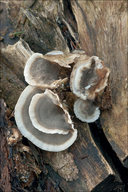|
|
click photo for larger file

Bjerkandera adusta
Smoky Bracket
|
Photographer: Dr. Amadej Trnkoczy
ID: 0000 0000 0115 1718 (2015-01-12)Copyright © 2015 Dr. Amadej Trnkoczy
|
|
INFORMATION PROVIDED WITH THE PHOTO
|
date of photo Dec 9, 2014
latitude 46.35624 longitude 13.69918
View on Google Maps.
location
Lower Trenta valley, left bank of river Soča between villages Soča and Trenta, 50 m downstream of the bridge to the farmhouse 'Matevž', Trenta 3, East Julian Alps (Posočje, Slovenia)notes Slo.: osmojena bjerkandera - syn.: Boletus crispus Pers. - Habitat: alpine valley, river bank, locally almost flat terrain, calcareous ground, river bank vegetation mostly consisting of Salix eleagnos, Picea abies and some Fagus sylvatica; humid air and ground, partly sunny, exposed to direct rain; average precipitations ~ 3.000 mm/year, average temperature 7-9 deg C, elevation 525 m (1.720 feet), alpine phytogeographical region. - Substratum: dead wood, a stump of cut down Salix eleagnos in its late initial phase of disintegration. - Comments: There exist two species of the genus Bjerkandera growing in Europe and also in Slovenia: Bjerkandera adusta and Bjerkandera fumosa. Both have very variable and irregular habitus and can be found pileate, effuse reflexed and also totally resupinate. Bjerkandera adusta is more common and can be distinguished from Bjerkandera fumosa by its very, very small more or less angular pores (5-7/mm), darker gray pore surface with pale margin and smaller spores. But distinguishing is not always easy. Bjerkandera adusta can be found during the whole year but it sporulates only at temperatures below 10 deg C (Ref.:4). So, one can hope to get spore print only during colder seasons of my country. Generally in the literature the pilei are described as azonate or only weakly zonate, however when they are very young this apparently doesn't hold (see Fig.4). - Growing in imbricate groups of several fruit bodies; pilei 1.2 - 2.8 cm across, trama pale brown, corky-fibrous (cannot be chewed over but can be nicely cut with a razor), up to 4.5 mm thick, pore layer dark-grey and distinctly darker then trama, about 1 mm thick; stipe absent; taste mild, slightly unpleasant but not bitter; smell on sour earth similar to Trametes versicolor; SP faint, whitish. - Spores smooth. Dimensions: 4.1 [4.5 ; 4.7] 5.1 x 2.6 [2.9 ; 3] 3.4 microns; Q = 1.3 [1.5 ; 1.6] 1.8; N = 37; C = 95%; Me = 4.6 x 3 microns; Qe = 1.6. Olympus CH20, NEA 100x/1.25, magnification 1.000 x, oil; in water, live material. AmScope MA500 digital camera. - Herbarium: Mycotheca and lichen herbarium (LJU-Li) of Slovenian Forestry Institute, Večna pot 2, Ljubljana, Index Herbariorum LJF - Ref.: (1) J. Breitenbach, F. Kraenzlin, Eds., Fungi of Switzerland, Vol.2. Verlag Mykologia (1986), p 268. (2) M. Bon, Parey's Buch der Pilze, Kosmos (2005), p 316. (3) L. Ryvarden, R.L. Gilbertson, European Polypores, part 1., Synopsis Fungorum 7., Fungiflora A/S (1993), p 168. (4) G.J. Krieglsteiner (Hrsg.), Die Grosspilze Baden-Württembergs, Band 1., Ulmer (2000), p 486. (5) A. Bernicchia, S.P.Gorjon, Cortitiaceaes.i., Fungi Europaei Vol.12., Edizioni Candusso (2010), p 139.camera Nikon D700/Nikkor Micro 105mm/f2.8
contributor's ID # Bot_854/2014_DSC5245 photo category: Fungi - fungi
|
MORE INFORMATION ABOUT THIS FUNGUS
|
| common names
Smoky Bracket (photographer)
View all photos in CalPhotos of Bjerkandera adusta Check Google Images for Bjerkandera adusta |
|
The photographer's identification Bjerkandera adusta has not been reviewed. Sign in to review or comment on this photo |
|
Using this photo The thumbnail photo (128x192 pixels) on this page may be freely used for personal or academic purposes without prior permission under the Fair Use provisions of US copyright law as long as the photo is clearly credited with © 2015 Dr. Amadej Trnkoczy.
For other uses, or if you have questions, contact Dr. Amadej Trnkoczy amadej.trnkoczy[AT]siol.net. (Replace the [AT] with the @ symbol before sending an email.) |
|
|
